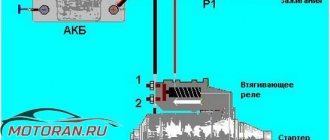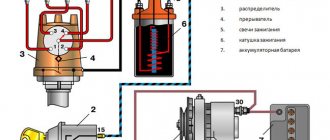Dima Kashevsky [kashevsky_dima]
04.10.2020,
I often encountered a problem when a VAZ would not start. Owners of injection and carburetor cars contacted us. Below I will list common causes that should help with your problem. Before that, it’s only worth saying that below we will talk about both old and new models. The material is voluminous, because I decided to describe everything in detail.
There are three main reasons why a domestic car does not want to start:
- Lack of fuel in the combustion chamber
- Lack of oxygen
- No ignition
As a rule, 80 percent of malfunctions lie in these three reasons. Let's take a closer look.
Ignition problems
The most common malfunction. The spark itself may exist, but its strength is not sufficient to ignite the fuel mixture. To identify the problem, the first step is to check the spark plugs.
In case anyone doesn't know, spark plugs can be found by the wide wires coming from them. We need to determine which candle has failed, because they cannot all break at once. To check, you need to start the VAZ engine and listen to the sound of its operation. Next, we unscrew the spark plugs one by one and listen to how the sound of the engine changes. When you remove a faulty spark plug, the sound of the engine will not change.
Inspect the unscrewed spark plug. By the carbon deposits on it you can determine why it failed. Most likely, the electrode will have one of the following deposits:
- Of red color. Occurs due to the addition of various additives to car fuel. If you see this type of carbon deposits, then you should refuse additives, because soon you will have to change the remaining spark plugs.
- White (similar to plaque). Indicates that the fuel mixture is unbalanced. This means that it is formed in the wrong oxygen/fuel ratio. There may be either an excess of fuel or an excess of oxygen.
- Matt black color. Occurs due to an excess of gasoline in the fuel mixture. Reason: the carburetor is incorrectly adjusted or the injector is not working correctly. Another symptom: increased fuel consumption.
- Oil black. Logically, this indicates increased oil consumption, which gets onto the electrode and interferes with the formation of a spark.
It is important to know! The spark plugs may be outwardly in good working order and the lack of a spark may be caused by filling the spark plug electrode with gasoline. This occurs due to a low battery charge.
Candles
To inspect the condition of the spark plugs, they must be unscrewed. The light brown reddish color of the candle, similar to the color of a brick, is an indicator of its working condition. The candle may be damp. This is a consequence of flooding the candles.
Spark plugs for VAZ 2114
The solution to the situation is to clean or blow out the cylinders. This is done by idling the starter with the spark plugs turned out. There may be carbon deposits on the spark plugs; in addition, the spark plug may be dark in color, which indicates the need to replace it. In winter, the candle may freeze. If you warm it up, clean it and put it in place, the engine will start.
Faulty starter
The problem with the starter on VAZs is very relevant. According to statistics, before a major overhaul of the engine, there is a need to repair the starter at least once. After checking the spark plugs, I advise you to pay attention to this mechanism and most likely the fault will lie there.
To determine the problem, you need to determine what type it is:
- Electric
- Mechanical
It is very easy to determine: if the starter does not turn and the VAZ does not start, then the problem is in the electrics. If you hear it spinning, then there is a mechanical problem. Let's figure out what can break down in the starter's electrics and what can go wrong in the mechanics.
Checking the contact.
Start checking with the simplest thing: inspecting the terminals on the mechanism body. Due to our “great” weather conditions, they like to oxidize, causing contact to be lost. As a result, the control impulse does not reach the motor and when we turn the ignition key we hear nothing. To clean the terminals, a regular fine knife or natfel will do.
Advice: to avoid corrosion of the terminals, you should treat them with lithol. It is first necessary to clean off any pockets of corrosion.
During the test, you will be able to confirm that there is no open circuit: each wire should be fixed to the starter terminals. Without diagrams on all VAZ models, the connection is similar:
- One “plus” from the battery goes to the starter terminal
- The second “plus” comes from the ignition switch through the fuse box
Check the fuse box, as a blown fuse breaks the circuit and no control voltage is supplied to the starter. Just visually check the fuse and if you see that it has burned out, replace it.
Checking the serviceability of the retractor
relay. This device is responsible for extending the bendix. Diagnosing a malfunction of the solenoid relay is easy, since it operates with a characteristic clicking sound.
A clicking sound appears when you turn the ignition key. If the solenoid relay does not click, then the problem lies with it or its fuse. Unfortunately, this part cannot be repaired, but it is inexpensive. By the way, there is a simple trick that often helps to revive a broken solenoid relay: you just tap it lightly with a hammer several times. In most cases this method works.
Broken Bendix gear teeth.
This is a rather rare type of reason why a VAZ will not start, but it is very easy to diagnose: an unpleasant metallic grinding sound will be heard from under the hood after turning the ignition key.
The problem is resolved by replacing the starter.
Another common reason why the starter does not turn and the VAZ does not start: a blown starter fuse. In this case, the solenoid relay does not click.
Ground wire
Ground wire VAZ 2114
This wire goes to the battery. There may be breaks at the point of contact with the body or at the terminal. The wire needs to be replaced. In addition, the cause of the malfunction is oxidation. Therefore, the wire should be thoroughly cleaned. A metal brush is suitable for this purpose. To clean the oxidation, the wire must be disconnected.
Fuel pump malfunction
With this malfunction, the Zhiguli engine starts, and then stalls or does not start at all. The first step is to check whether the fuel pump fuse is working properly, because according to statistics, 60 percent of VAZ fuel pump failures are associated with a blown fuse. In VAZ 2105 it is located in a block under the hood near the windshield, in VAZ 2107, 2109, 2115 in the cabin below the dashboard. In VAZ 2110, 2111 and 2112 it is located in the cabin in the place of the front passenger's feet. Next to the fuses there are relays, which are also responsible for the operation of the fuel pump. If the fault is not in the fuse or relay, then it lies either in the fuel pump itself or in its power supply circuit.
In carburetor VAZs, the fuel pump is located in the engine compartment next to the cylinder head.
All “classics” such as the Zhiguli were equipped with a fuel pump called DAAZ. Its catalog number is: 1106010. The part is very reliable, so the likelihood that the problem is with it is not high. And even if it breaks, you can buy repair kits.
In injection VAZs with a fuel pump, everything is not so fabulous.
It is hidden in the gas tank and likes to fail if there is little fuel inside. The pump motor is electric and is cooled by the gasoline itself, in which it is located. If there is little gasoline, the pump does not cool well, overheats and eventually breaks down.
The car may have difficulty starting due to low fuel content in the tank.
Fuel-air mixture
A mixture formed by the combination of air, gasoline and a spark that is necessary for combustion. The air supply is provided by sensors. If the sensors malfunction, the car engine should start. The main indicator of the need to replace sensors is high fuel consumption, which creates an idle problem. The real cause is the spark. Therefore, if there is excessive consumption and idle problems, diagnostics should be performed. If the engine does not start, then it is necessary to check the performance of the spark plugs.
Crankshaft position sensor
The sensor itself is very reliable, and there is nothing to break there. However, it can become clogged with a thick layer of dirt and stop functioning. The way out of the situation is simple: just wipe it. As a rule, it cannot become dirty immediately and the problem will manifest itself gradually: at first your VAZ does not start well, and after a month the car is no longer able to start.
Since a lot of dirt accumulates on this sensor, its contact with the wire simply rots. This is already a common problem, but it can be easily solved by manually restoring contact. The crankshaft sensor is located on the oil pump.
It is important to know! It is not permissible to make contact using twists. So you will lose it in a month, so it is best to solder the contact and cover it with lithol.
VAZ starts and immediately stalls
The car may stall immediately after starting, even due to trivial little things such as consumables. Therefore, first of all, I advise you to check the fuel and air filters. If they are clogged, it is difficult for the engine to receive oxygen and fuel, which causes it to simply stall.
If before your VAZ stopped starting, the following were discovered:
- Power Loss
- The car doesn't start well
- Increased fuel consumption
It is most likely that the catalyst that is equipped with VAZ injection models is faulty. The catalyst can be removed by flashing the engine control unit. As an alternative: install lambda decoys. A clogged catalyst may also be the reason why the VAZ does not start.
Operating principle
The quantity and quality of the fuel mixture in the injector is controlled electronically. Sensors are located throughout the engine unit, the signals from which are intercepted from the microprocessor and converted to the fuel supply system. The same processor controls the mixture ignition system in the combustion chamber
.
If any sensor malfunctions, the output control pulse ceases to correspond to the parameters of the normal functioning of the engine, and it refuses to work, in other words, it does not start.











